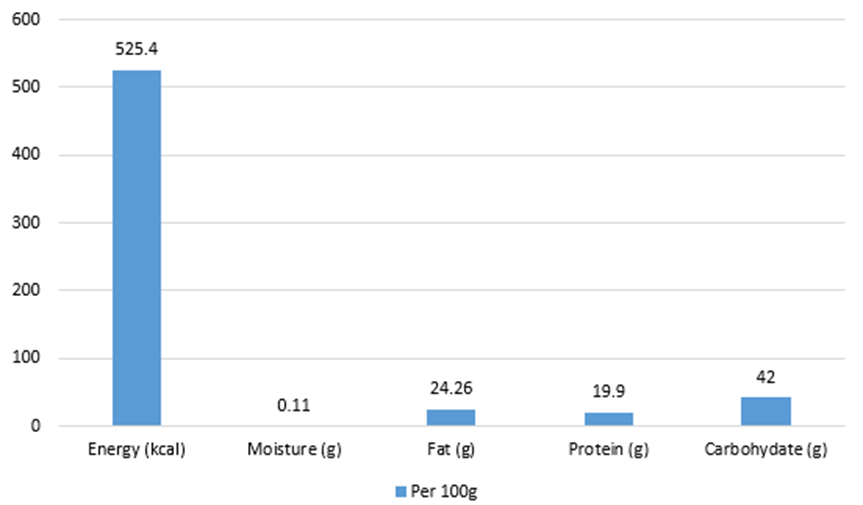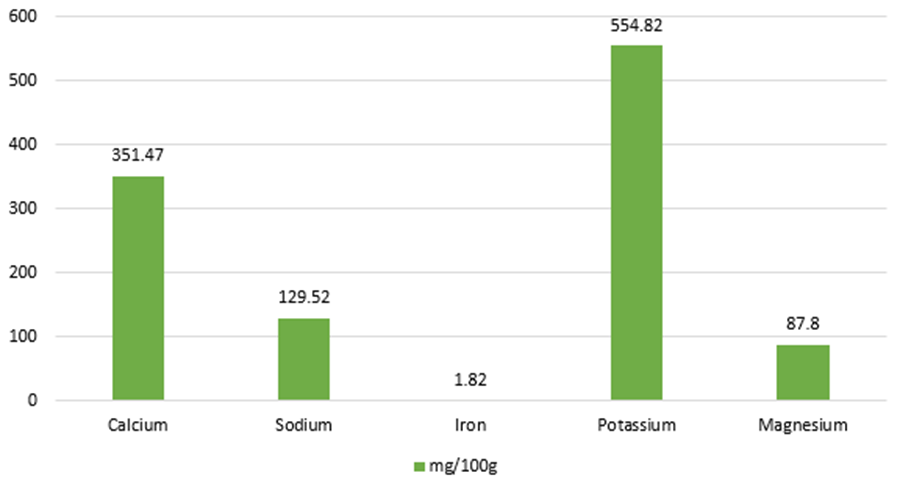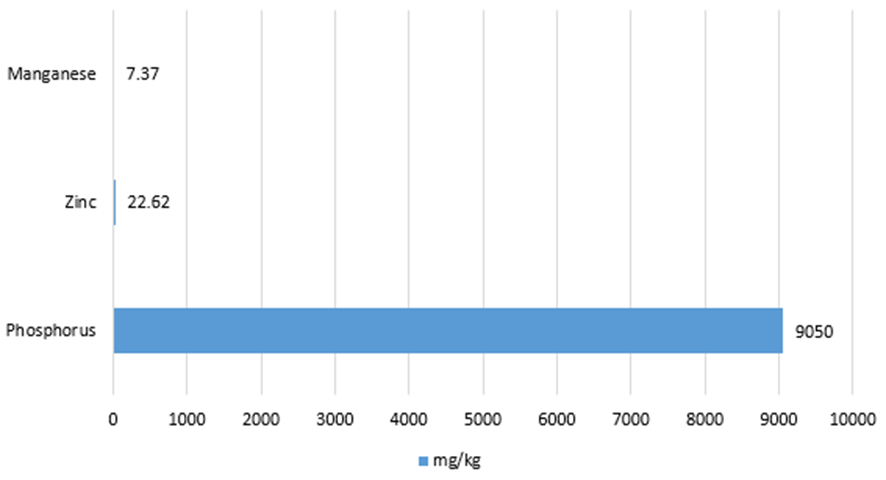AUCTORES
Globalize your Research
Research Article | DOI: https://doi.org/10.31579/2637-8914/302
1Research Scholar, Sharda School of Allied Health Sciences, Sharda University, Greater Noida, Uttar Pradesh, India.
2M.Sc. Student of Nutrition & Dietetics, Sharda School of Allied Health Sciences, Sharda University, Greater Noida, Uttar Pradesh, India.
3Assistant Professor, Department of Food Technology, Jamia Hamdard University, Delhi, India.
4,5Assistant Professor, Department of Nutrition & Dietetics, Sharda School of Allied Health Sciences, Sharda University, Greater Noida, Uttar Pradesh, India.
*Corresponding Author: Aditi Rikhari, Department of Nutrition & Dietetics, Sharda School of Allied Health Sciences, Sharda University, Greater Noida, Uttar Pradesh, India.
Citation: Krishna Bhattacharya, Purvi Gupta, Bushra Shahida, Aditi Rikhari, and Neelesh K. Maurya, (2025), Development of an Alternate to Nutrient-Dense Food for the Rehabilitation of Malnourished Children, J. Nutrition and Food Processing, 8(4); DOI:10.31579/2637-8914/302
Copyright: © 2025, Aditi Rikhari. This is an open access article distributed under the Creative Commons Attribution License, which permits unrestricted use, distribution, and reproduction in any medium, provided the original work is properly cited.
Received: 06 March 2025 | Accepted: 21 March 2025 | Published: 26 March 2025
Keywords: malnutrition; severe acute malnutrition (sam); ready-to-use therapeutic food (rutf); nutritional rehabilitation
A major public health concern still remains malnutrition, which increases death rates among children under five particularly in underdeveloped countries. A major issue is severe acute malnutrition (SAM); although Ready-to- Use Therapeutic Foods (RUTF) have shown promise, they are frequently expensive and difficult to get in settings with limited resources. This study aims to provide a substitute nutrient-dense meal with reasonably priced, locally produced ingredients to help malnourished children recover. Made with milk powder, coconut oil, powdered sugar, roasted chana powder, amylase-rich flour (ARF), and roasted peanut paste, the Amylase-Rich Flour-Wheat Chana Mixture (ARF-WCM) formulation While reducing antinutritional components like phytates and tannins, the components were carefully selected to optimise protein quality, digestibility, and mineral bioavailability. With an energy content of 525.4kcal per 100g, studies of proximal and mineral composition found that ARF-WCM is plentiful in protein, lipids, carbohydrates, and essential micronutrients. ARF-WCM has better protein and fat content than commercial substitutes like Nestum, although it keeps a balanced nutritional profile. Young children recovering from malnutrition would especially benefit from naturally occurring amylase enzymes in germinated wheat flour as they improve digestion and absorption. The findings show that ARF-WCM is a cheap and efficient dietary plan for SAM, hence improving food consumption and recovery in malnourished children. For community-based nutrition projects in resource- constrained settings, its simplicity of preparation, economy of cost, and nutritional value provide it a reasonable alternative.
Malnutrition is a substantial public health concern across the developing world and is a contributing factor in more than 50% of the 10–11 million avoidable deaths yearly among children under five years of age [1]. Asia possesses the highest population of children under five years old suffering from severe acute malnutrition (SAM), significantly hindering healthy human capital development [2]. The diagnostic criteria for SAM in children aged 6 to 59 months, as defined by the WHO and UNICEF, include any of the following: Weight-for-height z-score less than -3 standard deviations of WHO child growth criteria, presence of bilateral pedal oedema, and mid-upper-arm circumference (MUAC) less than 115 mm [3]. SAM is a primary contributor to mortality among children under five worldwide, impacting about 20 million children. A kid with SAM has a tenfold increased risk of mortality compared to a well-nourished peer. It is estimated that between 0.5 and 2 million fatalities are directly attributable to SAM annually. The case fatality rate for severe acute malnutrition in children under five years old varied between 20% and 50
2.1 Collection of Raw Material and Development of ARF-WC Mixture
Raw materials were gathered, including dry milk powder, whole wheat grains, peanuts, chickpeas, coconut oil, and powdered sugar. All ingredients were precisely chosen to improve protein quality, digestibility, and mineral bioavailability, while minimising antinutritional elements like phytates and tannins.
The whole wheat grains were meticulously washed to eliminate dirt and extraneous impurities, after which they were germinated. Germination of whole wheat enhances the enzyme amylase. The germinated whole wheat was milled to produce flour, known as amylase-rich flour (ARF). ARF transforms the dense starch of ungerminated flour into a simple, easily digested form suitable for young children [11]. The chana and peanut were also cleaned, dry roasted, dehulled, and ground into a powder and paste, respectively. All materials were measured according to Table-1 and thoroughly mixed to prevent lump formation. The amount of ARF used in forming the product has 10% of a volume of prepared food, for example, 2 tsp (10 g) per 100 g of food. The amalgamation was preserved in a hermetically sealed vessel to avert contamination and rancidity.
| Ingredients | Milk Powder | Coconut Oil | Powdered Sugar | Roasted Chana Powder | ARF | Roasted peanut paste |
| Amount | 30g | 25g | 15g | 10g | 10g | 10g |
Table 1: Formulation of ARF-WCM
2.2 Determination of Proximate Composition
Moisture, fat, protein and carbohydrate content of the ARF-WCM were estimated using proximate analysis. Moisture and fat were analysed using the hot air oven technique and Soxhlet method, respectively. The total nitrogen content was determined using the microkjeldhal technique, and further, the value for crude protein was multiplied by 6.25. The total Carbohydrate were estimated as per AOAC method.
2.3 Analytical Procedure for Mineral Analysis
Chemical analyses were conducted to ascertain the concentrations of sodium (Na), potassium (K), calcium (Ca), magnesium (Mg), zinc (Zn), phosphorus (P), manganese (Mn), and iron (Fe). The analysis of aqueous digest was conducted using an Atomic Absorption Spectrophotometer (Varian, AA 240FS, Australia) for the determination of Ca, Mg, Zn, Mn, and Fe, which was equipped with both flame and graphite furnace capabilities [12]. The flame photometer was employed to quantify sodium and potassium [13]. AOAC 995.11 was used to determine P [14].
All the data was recorded and analysis was done using mathematical equations.
The proximate analysis quantified the energy, fat, moisture, protein, and carbohydrate content in ARF-WCM. The energy content of ARF-WCM was determined to be 525.4 kcal per 100 g, while the moisture content was measured at 0.11 g per 100 g of ARF-WCM. The ARF-WCM was found to have elevated concentrations of fat, protein, and carbohydrates, specifically 24.26g/100g, 19.9g/100g, and 42g/100g, respectively. In comparison to commercially available Nestum, which provides 370 kcal of energy, 6 g of protein, 86.2 g of carbohydrates, and 0.2 g of fats per 100 g, our ARF-WCM demonstrates a higher protein content and a lower carbohydrate content.

Figure 1: Proximate Composition of ARF-WCM/100g
The mineral analysis quantified the estimated concentrations of calcium, sodium, iron, potassium, zinc, phosphorus, and magnesium in ARF-WCM. The calcium concentration of ARF-WCM was measured at 351.47 mg/100g, sodium at 129.52 mg/100g, potassium at 554.82 mg/100g, magnesium at 87.7 mg/100g, and iron at 1.82 mg/100g. The concentrations measured were as follows: phosphorus at 9050 mg/kg, zinc at 22.62 mg/kg, and manganese at 7.37 mg/kg. Compared to Nestum, which contains 325mg/100g of calcium, 200mg/100g of potassium, and 2mg/100g of iron, our ARF-WCM exhibits higher levels of calcium and potassium, while the iron content is nearly equivalent.

Figure 2: Mineral analysis of ARF-WCM mg/100g

Figure 3: Mineral analysis of ARF-WCM mg/kg
The findings of this study highlight the potential of the suggested Amylase-Rich Flour-Wheat Chana Mixture (ARF-WCM) as a nutritionally rich and reasonably priced treatment for children suffering with Severe Acute Malnutrition (SAM). ARF-WCM is a better choice than commercially sold goods like Nestum, which has much lower protein (6 g/100 g) and fat (0.2 g/100 g), with the higher protein (19.9 g/100 g) and fat (24.26 g/100 g). This assures ARF-WCM provides enough macronutrient support for complete development in malnourished children, immunological effectiveness, and muscle rebuilding.
ARF-WCM mostly benefits from the presence of amylase-rich flour (ARF), which enzymatically breaks down complicated starches into simpler ones, therefore improving digestion. This technique replics the action of commercial digestion boosters like maltose, but it is achieved organically by germination, so ARF-WCM is a more readily available and easily digested substitute for young children with compromised digestive systems. Reducing phytates, tannins, and chymotrypsin inhibitors helps to improve the bioavailability of important minerals including iron, calcium, and zinc, therefore addressing common shortages in underdeveloped areas [11,15,16].
The mineral analysis of ARF-WCM indicates its potential as a food rich in micronutrients. The elevated calcium (351.47 mg/100 g) and potassium (554.82 mg/100 g) concentrations promote bone health and electrolyte equilibrium, essential during the recovery period of malnourished children [17,18]. The iron concentration (1.82 mg/100 g), while equivalent to commercial goods, is vital for preventing anaemia, a prevalent disorder linked to malnutrition. Zinc concentrations of 22.62 mg/kg and phosphorous concentrations of 9050 mg/kg are critical for the rapid development and recovery of malnourished children, since they enhance cellular function and immunological support [19,20].
Since ARF-WCM uses locally grown components, it offers a better nutritional profile than commercially sold therapeutic meals and is more accessible and less expensive. The reliance on imported RUTFs in many underdeveloped countries creates logistical and financial challenges, therefore limiting their general availability. Using easily accessible and reasonably priced components, ARF-WCM becomes a viable substitute for large-scale community-based nutrition projects [21].
This study acknowledges certain constraints even if it has benefits. Although the nutritional analysis shows the effectiveness of ARF-WCM, more clinical trials and acceptability studies are required to evaluate its practical relevance in children with SAM. Moreover, elements related to shelf stability, taste preference, and extended storage conditions have to be investigated to ensure useful use and customer satisfaction.
Therefore, ARF-WCM provides better nutritional content, improved digestibility, and cost-effectiveness, so acting as a suitable and quick replacement for commercial therapeutic meals. Later studies should focus on clinical trials, strengthening strategies, and wide-ranging application to establish ARF-WCM as the accepted intervention in programs for malnutrition control.
This study highlights the potential of an Amylase-Rich Flour-Wheat Chana Mixture (ARF-WCM) as a cost-effective, nutrient-dense treatment for the recuperation of newborns with SAM. The dish offers a balanced macronutrient and micronutrient profile using inexpensive, locally grown ingredients, making it a viable substitute for therapeutic meals that are sold commercially. The higher protein and fat levels of ARF-WCM compared to commercial goods support their effectiveness in lowering malnutrition, in addition to the utilisation of ARF to aid in digestion. By removing antinutritional components and enhancing mineral bioavailability, ARF-WCM facilitates improved absorption of essential minerals, hence assisting in the growth and recuperation of children. ARF-WCM's affordability and ease of preparation make it a viable substitute for costly imported Ready-to-Use Therapeutic Foods (RUTFs) in community-based nutrition initiatives. ARF-WCM shows promising results, but further study is required to confirm its practical utility, including clinical trials and thorough implementation studies. Additional research must examine shelf stability, consumer acceptability, and potential nutritional fortification in order to improve its long-term efficacy.
Essentially, ARF-WCM provides a cost-effective, nutritionally comprehensive, and scientifically validated way to address childhood malnutrition, allowing for better health outcomes in resource-constrained environments.